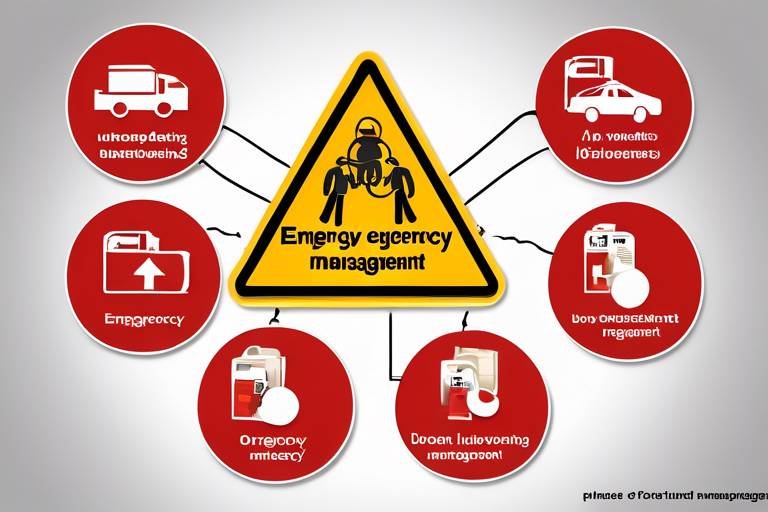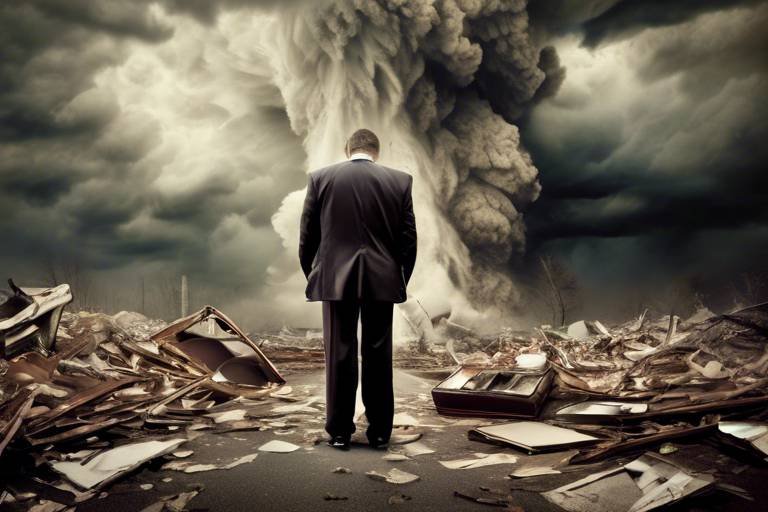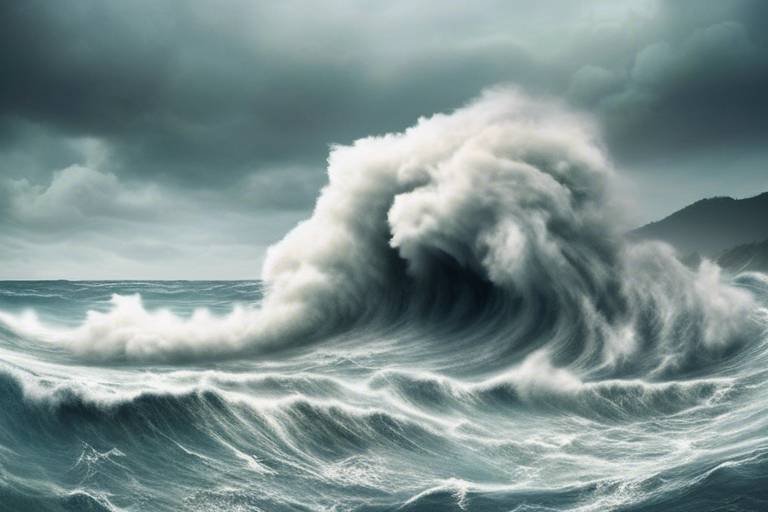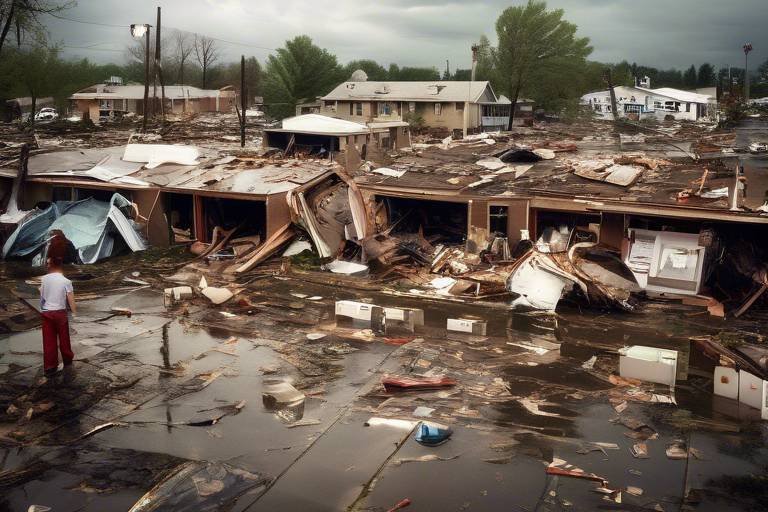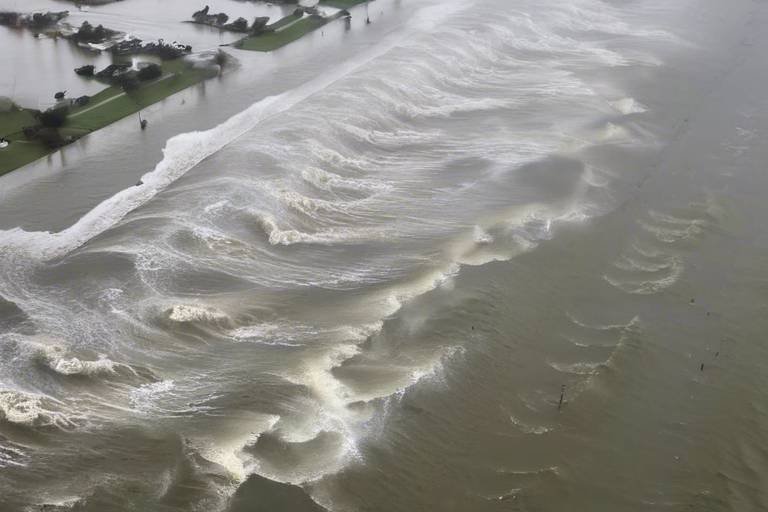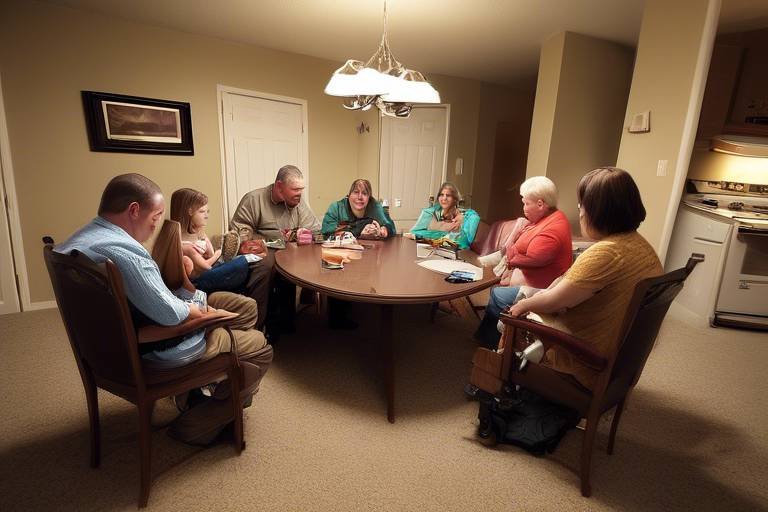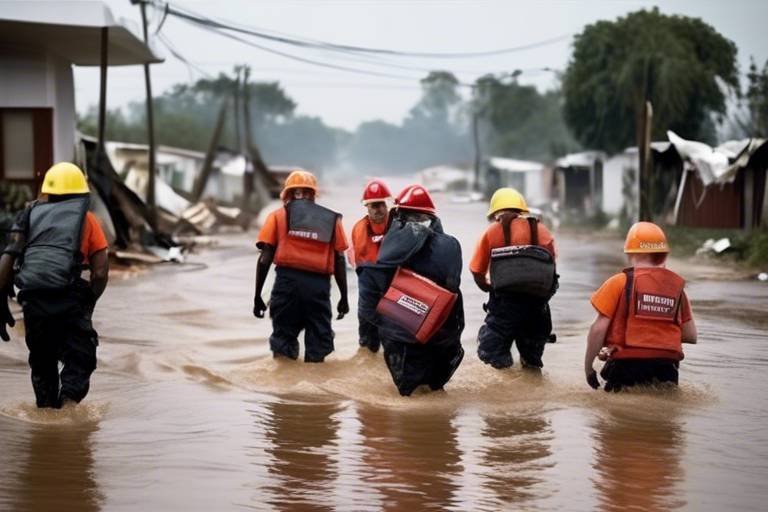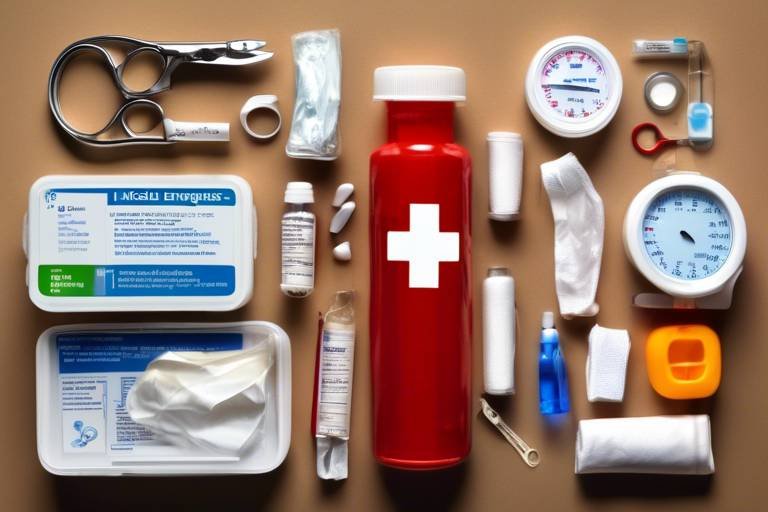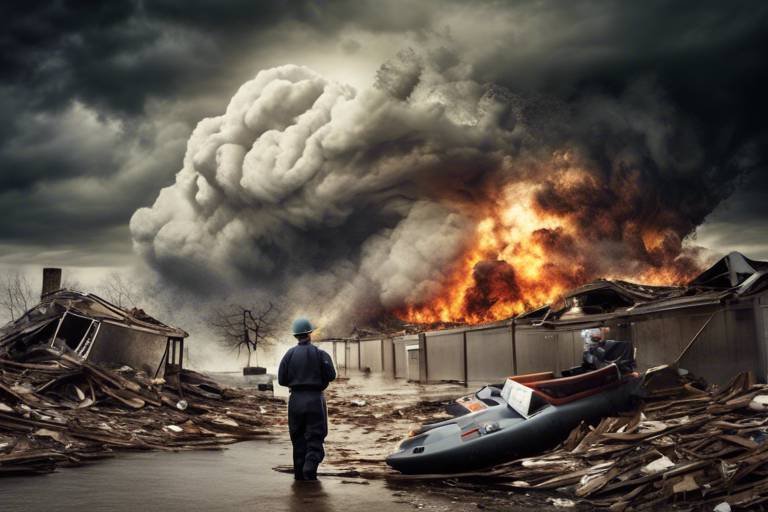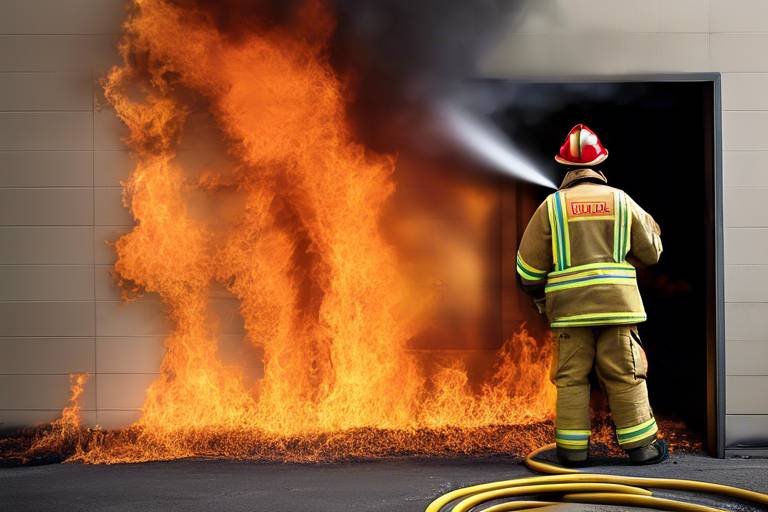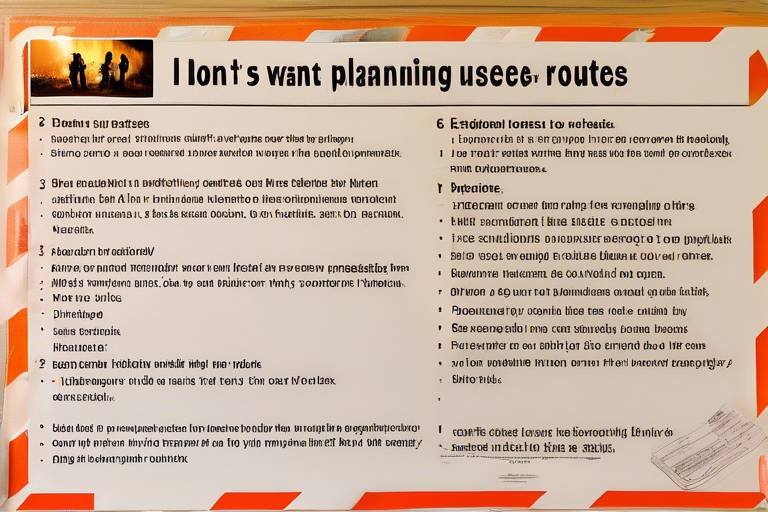Blizzards and Snowstorms - Essential Preparedness Tips
When winter rolls around, blizzards and snowstorms can hit with little warning, transforming our everyday lives into a frosty challenge. These severe weather events can be both beautiful and dangerous, creating a winter wonderland while also posing significant risks to our safety and well-being. To navigate through these icy trials, it’s essential to arm yourself with knowledge and preparation strategies. By understanding the nature of blizzards and snowstorms and taking proactive steps, you can ensure your safety and minimize disruptions during these harsh winter conditions.
Blizzards are not just ordinary snowstorms; they are characterized by their **strong winds** and **low visibility**, often leading to life-threatening conditions. Picture a swirling vortex of snow and wind, where the landscape becomes obscured, and even the most familiar routes can turn into a maze of white. Understanding how these storms form is crucial. They typically arise when warm, moist air collides with cold air, leading to heavy snowfall and fierce winds. This combination can cause whiteouts, making it nearly impossible to see just a few feet ahead. Knowing what to expect can help you prepare effectively.
Home preparation is your first line of defense against the elements. Think of your home as a fortress against the winter's chill. Start by ensuring that your home is properly insulated to keep the warmth in and the cold out. Check your windows and doors for drafts, and consider using weather stripping or thermal curtains. Additionally, having a reliable heating source is crucial. In the event of a power outage, alternative heating methods, such as fireplaces or wood stoves, can keep you warm and cozy. But don't forget about your emergency supplies!
Your emergency kit should be a treasure chest of essential items that can make a significant difference during a storm. Imagine being snowed in with everything you need at your fingertips. Here’s what to include:
- Non-perishable food: Canned goods, dried fruits, and nuts.
- Water: At least one gallon per person per day for three days.
- First-aid supplies: Band-aids, antiseptics, and any necessary medications.
- Flashlights: Keep a few handy with extra batteries.
Assembling your kit in advance can save you a lot of stress when the storm hits. Make sure to check and replenish your supplies regularly.
It’s important to have a stash of food and water that can last several days. Think of it as your survival pantry! Recommended items include:
- Canned soups and stews
- Peanut butter and jelly
- Granola bars
- Instant coffee or tea
Store these items in a cool, dry place, and rotate them out periodically to ensure freshness. Don’t forget about water—having enough to stay hydrated is crucial.
A well-stocked first-aid kit is a must-have in your emergency preparations. Imagine being able to tend to minor injuries without having to venture out into the storm. Essential items include:
- Adhesive bandages of various sizes
- Gauze pads and tape
- Antiseptic wipes
- Scissors and tweezers
Regularly check your first-aid kit to ensure that supplies are not expired and that you have everything you need for emergencies.
Maintaining heat during a blizzard is critical. If the power goes out, having alternative heating methods is essential. Consider using a generator, but make sure to follow safety guidelines to prevent carbon monoxide poisoning. Additionally, keep extra blankets and warm clothing accessible, so you can stay warm even if the temperature drops inside your home.
Staying updated on weather conditions is vital for your safety. In this digital age, accessing reliable information is easier than ever. Use your smartphone or a battery-operated radio to keep track of weather alerts, forecasts, and emergency updates. Being informed can help you make timely decisions, whether it’s staying put or evacuating if necessary.
Understanding different weather alerts can help you prepare effectively. Here’s a quick breakdown of what they mean:
| Alert Level | Description |
|---|---|
| Watch | Conditions are favorable for severe weather. |
| Warning | Severe weather is occurring or imminent. |
| Advisory | Minor weather conditions that may cause inconvenience. |
Establishing a communication plan with family and friends ensures everyone stays informed. Think of it as your safety net during the storm. Decide on a designated meeting place and a way to check in with each other, whether it's through text, social media, or a simple phone call. This way, you can rest easy knowing that everyone is accounted for.
Traveling during a blizzard can be treacherous. If you must go out, make sure to take precautions. Always check the weather before heading out and consider whether your trip is necessary. If you do decide to travel, ensure your vehicle is winter-ready. This means checking your tires, keeping your gas tank full, and having an emergency kit in your car.
Driving in snowy conditions requires special precautions. Think of it as navigating a slippery dance floor—slow and steady wins the race! Here are some tips:
- Increase your following distance.
- Use low gears to maintain traction.
- Keep your headlights on, even during the day.
By taking these precautions, you can minimize risks and help ensure your safety on the road.
When travel is necessary, public transportation can be a safer alternative. Buses and trains are often equipped to handle winter weather better than personal vehicles. Check local schedules and be prepared for delays. Carry a small bag with essentials, like snacks and a book, to keep you comfortable while you wait.
Even after the storm has passed, safety should remain a priority. Assessing damage to your property is crucial. Look for downed power lines, fallen branches, or structural damage. If you notice anything concerning, report it to the appropriate authorities.
After the storm, take the time to inspect your home and property. Look for:
- Roof damage
- Broken windows
- Flooding in basements
Document any issues with photos for insurance purposes, and reach out to your insurance provider to report damages.
Clearing snow can be physically demanding and dangerous. Use safe techniques and tools to avoid injury. When shoveling, remember to lift with your legs, not your back, and take frequent breaks. If the snow is too heavy, consider hiring a professional to help. Your health is worth more than a few extra dollars!
1. How can I prepare for a blizzard?
Prepare by stocking up on food, water, and emergency supplies. Ensure your home is insulated and have a reliable heating source.
2. What should I include in my emergency kit?
Your kit should include non-perishable food, water, first-aid supplies, flashlights, and extra batteries.
3. What are the signs of a blizzard?
Signs include heavy snowfall, strong winds, and low visibility. Always heed weather alerts and warnings.
4. How can I stay informed during a storm?
Use your smartphone, battery-operated radio, or NOAA Weather Radio to receive updates and alerts.

Understanding Blizzards
Blizzards are not just your average winter storms; they are severe weather events that can turn a picturesque snowy landscape into a treacherous environment in the blink of an eye. Characterized by strong winds, heavy snowfall, and low visibility, a blizzard can create hazardous conditions that make even the simplest tasks seem daunting. Imagine being caught in a whiteout where you can't see a foot in front of you—this is the reality of a blizzard. Understanding how these storms form and their potential impacts is crucial for effective preparedness and response.
A blizzard typically occurs when a combination of cold air, moisture, and strong winds come together. The National Weather Service defines a blizzard as a storm that produces sustained winds or frequent gusts of 35 mph or greater, along with considerable snowfall that reduces visibility to less than a quarter of a mile for an extended period—usually three hours or more. This combination can lead to dangerous conditions, making travel nearly impossible and causing significant disruptions to daily life.
To illustrate the effects of blizzards, consider the following table that highlights the key characteristics of a blizzard compared to a regular snowstorm:
| Characteristic | Blizzard | Snowstorm |
|---|---|---|
| Wind Speed | ≥ 35 mph | Varies |
| Visibility | ≤ 1/4 mile | Generally better |
| Duration | ≥ 3 hours | Varies |
| Impact on Travel | Severe | Moderate to Severe |
As you can see, the intensity and duration of blizzards significantly elevate the risks associated with winter weather. The combination of high winds and snow can lead to snowdrifts that block roads, making them impassable. Furthermore, the extreme cold associated with these storms can lead to frostbite and hypothermia in just a matter of minutes if one is exposed to the elements without proper protection.
In addition to the immediate dangers, blizzards can also disrupt essential services such as electricity, heating, and transportation. Power outages are common during these storms, and being without heat during frigid temperatures can be life-threatening. Therefore, understanding the nature of blizzards is not just about recognizing their beauty; it's about preparing for their potential wrath.
In conclusion, being informed about the characteristics and dangers of blizzards can empower you to take the necessary precautions to keep yourself and your loved ones safe. Remember, knowledge is your best defense against the unpredictable forces of nature!

Preparing Your Home
When winter arrives, preparing your home for the inevitable blizzards and snowstorms is not just a good idea; it’s a necessity. Imagine being snowed in, with no heat and dwindling supplies—it’s a nightmare scenario that can be easily avoided with a bit of foresight. To ensure your family’s safety and comfort, focus on three critical areas: insulation, heating, and emergency supplies. Each of these components plays a vital role in weathering the storm.
First and foremost, insulation is key. A well-insulated home keeps the warmth in and the cold out, making it easier to maintain a comfortable temperature when the power goes out. Check your walls, attic, and basement for proper insulation. If you feel drafts or notice cold spots, consider adding insulation materials or sealing gaps around windows and doors. This simple step can significantly reduce your heating costs and keep your home cozy during those frigid nights.
Next up is heating. You’ll want to make sure your heating system is in top shape before the snow starts to fall. Schedule a professional inspection to ensure everything is working efficiently. If you have a fireplace or wood stove, stock up on firewood, and make sure your chimney is clean to prevent any fire hazards. In addition, consider having a backup heating source, like a space heater or a generator. Just remember, if you’re using alternative heating methods, always follow safety guidelines to prevent carbon monoxide poisoning.
Now, let’s talk about emergency supplies. Having a well-prepared emergency kit can be a lifesaver during a blizzard. Your kit should include:
- Non-perishable food items (canned goods, dried fruits, nuts)
- At least a three-day supply of drinking water
- First-aid supplies
- Flashlights with extra batteries
- Blankets or sleeping bags
Don’t forget to check the expiration dates on food and medicine regularly to ensure everything is fresh and usable when the time comes. Having these essentials on hand can make all the difference in keeping your family safe and comfortable during a storm.
Additionally, it’s wise to prepare your outdoor areas. Clear gutters, trim overhanging branches, and secure patio furniture to prevent them from becoming dangerous projectiles in high winds. If you have a snow shovel, make sure it’s in good condition and easily accessible. You might also want to consider purchasing a snow blower if you live in an area that frequently experiences heavy snowfall.
In conclusion, preparing your home for a blizzard involves a combination of proper insulation, a reliable heating source, and a well-stocked emergency kit. By taking these steps, you can ensure that you and your loved ones remain safe and comfortable, no matter what Mother Nature throws your way. Remember, preparation is the best defense against the chaos of winter storms!
Q: How can I tell if my home is properly insulated?
A: Check for drafts around windows and doors, and feel for cold spots in your home. You may also want to consider hiring a professional to conduct an energy audit.
Q: What should I include in my emergency kit?
A: Your emergency kit should contain non-perishable food, water, first-aid supplies, flashlights, batteries, blankets, and any necessary medications.
Q: How can I safely heat my home during a power outage?
A: Use a wood stove or fireplace if available, and consider having a generator as a backup. Always ensure proper ventilation to avoid carbon monoxide buildup.
Q: What outdoor preparations should I make?
A: Clear gutters, trim trees, secure outdoor furniture, and ensure that your snow removal tools are accessible and in good condition.

Emergency Kits
When winter storms hit, having an emergency kit ready can be the difference between chaos and calm. Think of it as your safety net during a blizzard—an essential collection of supplies that ensures you and your family can weather the storm without unnecessary stress. So, what should you include in this kit? Let’s break it down!
Your emergency kit should contain a variety of essential items that cater to both immediate and longer-term needs. At a minimum, it’s wise to have the following:
- Food: Non-perishable items like canned goods, granola bars, and dried fruits are ideal. Aim for at least a three-day supply.
- Water: Store at least one gallon of water per person per day for at least three days.
- First-Aid Supplies: Bandages, antiseptics, and any necessary medications should be included.
- Flashlights and Batteries: Power outages are common during severe winter weather, so be prepared with reliable light sources.
- Emergency Blanket: These compact, heat-retaining blankets can be a lifesaver in cold conditions.
But wait, there's more! Think about your family’s specific needs. Do you have young children or pets? If so, consider adding items like baby formula, pet food, and comfort items like toys or blankets to keep spirits high. It’s all about creating a kit that feels personalized and comprehensive.
Now, let’s talk about the storage of your emergency kit. A waterproof container is ideal to keep everything dry and protected. You might even want to store your kit in a place that’s easily accessible, such as a closet near the front door or in the garage. Remember, the best time to prepare is before the storm hits!
Regularly check and update your emergency kit. Food items can expire, batteries can die, and medications can change. Make it a habit to review your kit every six months—perhaps during a seasonal change. This way, you ensure that your supplies are always fresh and ready to go.
In summary, a well-prepared emergency kit is your best friend when blizzards and snowstorms strike. It’s not just about survival; it’s about peace of mind. Knowing you have everything you need at your fingertips allows you to focus on what really matters—keeping yourself and your loved ones safe and warm. So, take the time to gather your supplies, and you’ll be ready to face whatever winter throws your way!
Q: How often should I check my emergency kit?
A: It's a good idea to check your emergency kit every six months to ensure all supplies are fresh and functional.
Q: What should I do if I have specific dietary needs?
A: Customize your emergency kit with food items that meet your dietary restrictions, such as gluten-free or vegan options.
Q: Is it necessary to have a first-aid kit?
A: Yes! A first-aid kit is crucial for treating minor injuries that may occur during a storm or while clearing snow.
Q: Can I use regular household items in my emergency kit?
A: Absolutely! Items like candles, matches, and even a manual can opener can be very useful during an emergency.

Food and Water Supplies
When it comes to preparing for a blizzard, ensuring you have sufficient is paramount. Imagine being snowed in, with howling winds outside, and the only thing keeping you company is your well-stocked pantry. It’s comforting to know that you’re ready for whatever Mother Nature throws your way. So, what should you have on hand? Let’s break it down!
First and foremost, focus on non-perishable food items. These are your best friends during a storm because they can last for an extended period without refrigeration. Think about canned goods, dried fruits, nuts, and even instant oatmeal. You want to choose foods that are easy to prepare and can provide the necessary energy to get through those cold, dreary days. Here’s a quick list of essentials to consider:
- Canned vegetables and beans
- Pasta and rice
- Peanut butter
- Granola bars
- Powdered milk or shelf-stable milk alternatives
Now, let’s talk about water supplies. It’s recommended to have at least one gallon of water per person per day, and you should ideally have enough to last for at least three days. Don’t forget to account for your pets too! Water can be stored in clean, plastic containers, and it’s wise to rotate your supplies every six months to ensure freshness. If you’re thinking of adding some flavor to your water, consider including electrolyte packets, which can help keep you hydrated during stressful times.
Additionally, it’s crucial to keep your food supplies organized. Use clear bins to store your items, so you can easily see what you have without digging through piles of cans. Label everything with expiration dates to keep track of what needs to be used first. This small step can save you time and stress when the storm hits.
Lastly, don’t overlook the importance of having a manual can opener handy! It’s a simple tool, but if you find yourself without power, it will be invaluable when you’re trying to access those canned goods. So, as you prepare for the blizzard, take a moment to assess your food and water supplies. You’ll be grateful you did when you’re cozy at home, knowing you’re ready for anything!
Q: How much food should I store for a blizzard?
A: Aim for at least a three-day supply of food for each person in your household, focusing on non-perishable items that are easy to prepare.
Q: Can I use tap water for my emergency supply?
A: Yes, you can use tap water, but it’s best to store it in clean, food-grade containers. Remember to rotate your water supply every six months.
Q: What are some quick meals I can prepare during a blizzard?
A: Consider meals like canned soup, pasta with jarred sauce, or instant oatmeal. These options are quick to prepare and require minimal cooking.
Q: How can I keep my food from spoiling if the power goes out?
A: Keep your refrigerator and freezer doors closed as much as possible. A full freezer can keep food frozen for up to 48 hours if unopened.

First-Aid Essentials
When preparing for a blizzard, having a well-stocked first-aid kit is not just a good idea—it's essential. Imagine being snowed in, cut off from help, and facing a minor injury or illness. That’s when your first-aid kit becomes your best friend! So, what should you include in this lifesaver? Let's break it down.
Your first-aid kit should contain a variety of supplies to address common injuries and health issues that could arise during severe winter weather. At a minimum, you should have:
- Adhesive Bandages: These are crucial for covering small cuts and abrasions.
- Antiseptic Wipes: Use these to clean wounds and prevent infections.
- Gauze Pads and Tape: For larger wounds that need to be covered securely.
- Antibiotic Ointment: A must-have to apply on cuts to help prevent infection.
- Scissors and Tweezers: Handy for cutting tape or gauze and removing splinters.
- Pain Relievers: Over-the-counter medications like ibuprofen or acetaminophen can help alleviate pain or fever.
- Thermometer: To monitor body temperature in case of illness.
It’s also wise to include any personal medications that you or your family members may need, such as asthma inhalers or allergy medications. Don’t forget to check expiration dates regularly and replace any expired items. Keeping your first-aid kit in a designated, easily accessible location is also crucial, especially when time is of the essence during an emergency.
In addition to the basic supplies, consider adding some specialized items for winter-specific injuries. For instance, include a cold pack to reduce swelling from sprains or strains, which can be more common when navigating icy conditions. Also, think about including a space blanket, which can provide warmth in case of hypothermia.
Lastly, while assembling your first-aid kit, think about creating a small first-aid manual or guide. This can be a simple printed sheet that outlines basic first-aid procedures, such as how to handle cuts, burns, or sprains. In the heat of the moment, having clear instructions can make all the difference.
Overall, being prepared with a comprehensive first-aid kit can provide peace of mind during blizzard conditions. It’s like having a safety net—one that ensures you’re ready to tackle whatever the storm throws your way!
Q: How often should I check my first-aid kit?
A: It's a good idea to check your first-aid kit at least twice a year, ideally before the winter season starts, to replace expired items and ensure you have everything you need.
Q: Can I use my first-aid kit for non-emergency situations?
A: Absolutely! Your first-aid kit can be handy for minor injuries or ailments that occur at any time, not just during emergencies.
Q: What if I have specific medical needs?
A: If you or someone in your household has specific medical conditions, be sure to include necessary medications and supplies in your first-aid kit, such as inhalers or EpiPens.

Heating and Power
When a blizzard strikes, maintaining warmth in your home becomes a top priority. The biting cold can seep in through the tiniest cracks, making it essential to have a solid plan in place. First off, ensure that your heating system is functioning optimally before the storm hits. Schedule a maintenance check-up for your furnace or boiler, as a well-maintained system is less likely to fail when you need it the most. But what happens if the power goes out? This is where alternative heating sources come into play, and it's crucial to be prepared.
One of the safest alternatives is a wood stove or a fireplace. Not only can they provide warmth, but they also create a cozy atmosphere that can lift spirits during a storm. However, it’s essential to have a sufficient supply of dry wood and ensure proper ventilation to avoid carbon monoxide buildup. If you don't have a fireplace, consider investing in a portable propane heater. These heaters can be a lifesaver, but remember to use them only in well-ventilated areas to prevent the risk of suffocation.
Now, let’s talk about power outages. It’s not just about keeping warm; you also need to consider how to keep your devices charged and your food from spoiling. A generator can be a fantastic investment. Generators come in various sizes and can power everything from your refrigerator to your heating system. However, it's crucial to operate them safely—always place them outdoors to avoid carbon monoxide poisoning. If you're considering a generator, familiarize yourself with its operation and keep extra fuel on hand.
In addition to generators, having a stock of batteries, flashlights, and solar chargers can help keep your essential devices running. Imagine being able to charge your phone or keep a lamp lit in the darkest hours of the night! Don’t forget to also stock up on candles and matches as a backup light source, but use them with caution to avoid fire hazards.
Here’s a quick table summarizing some alternative heating and power options you might consider:
| Heating Source | Pros | Cons |
|---|---|---|
| Wood Stove | Reliable, creates ambiance | Requires wood supply, ventilation needed |
| Portable Propane Heater | Portable, effective | Must be used outdoors or in well-ventilated areas |
| Generator | Powers multiple devices | Requires fuel, must be used outside |
Ultimately, the key to surviving a blizzard lies in your preparation. By ensuring your heating system is ready and considering backup options, you can keep your home warm and your family safe. Remember, it’s not just about surviving the storm but also about making the experience as comfortable as possible. So, take the time to plan ahead, and you’ll be thankful when the snow starts to fall!
- What should I do if my heating system fails during a blizzard?
If your heating system fails, use alternative heating sources like a wood stove or portable propane heater, ensuring proper ventilation. Keep warm by layering clothing and using blankets. - How can I prevent carbon monoxide poisoning?
Always use generators and propane heaters outdoors, away from windows and doors. Install carbon monoxide detectors to alert you of dangerous levels. - What are the best foods to store for a blizzard?
Focus on non-perishable items like canned goods, dried fruits, nuts, and granola bars. Don’t forget about drinking water—store at least one gallon per person per day.

Staying Informed
In today's world, staying informed is more crucial than ever, especially when it comes to severe winter weather like blizzards and snowstorms. The last thing you want is to be caught off guard when the snow starts to fall and the winds begin to howl. So, how do you ensure that you are always in the loop? First and foremost, it's important to establish reliable sources for weather updates. This could be through local news stations, weather apps on your smartphone, or even NOAA Weather Radio, which provides continuous broadcasts of weather information. Having multiple sources can help confirm the accuracy of the information you're receiving.
In addition to monitoring weather updates, understanding the various weather alerts is essential. These alerts can range from a simple advisory to a full-blown blizzard warning. Knowing what each alert means can significantly impact your preparedness. For instance, a winter storm watch indicates that conditions are favorable for a storm, while a winter storm warning means that severe weather is imminent. Being able to interpret these alerts can help you make timely decisions about your safety and the safety of your loved ones.
Moreover, establishing a communication plan with your family and friends is vital. In the chaos of a snowstorm, it’s easy to lose touch. Create a strategy for how you will communicate during a storm. This could involve designating a central contact person or using group messaging apps to keep everyone updated. Make sure everyone knows how to reach each other and what to do if the power goes out. This way, even if you’re snowed in, you won’t feel isolated.
To further enhance your preparedness, consider using a simple chart to track weather alerts and your communication plan. Here’s a basic example:
| Alert Level | Description | Action Required |
|---|---|---|
| Winter Storm Watch | Conditions are favorable for a winter storm within the next 48 hours. | Stay informed; prepare emergency kits. |
| Winter Storm Warning | Severe winter weather is occurring or will occur soon. | Take immediate precautions; avoid travel. |
| Blizzard Warning | Blizzard conditions are expected, with strong winds and low visibility. | Stay indoors and follow safety protocols. |
By keeping yourself informed and prepared, you can navigate the challenges of blizzards and snowstorms with confidence. Remember, knowledge is power, and the more you know, the better equipped you'll be to handle whatever winter throws your way.
- What should I do if I lose power during a blizzard? Stay indoors, use flashlights instead of candles, and conserve your phone battery for emergencies.
- How can I prepare my home for a snowstorm? Insulate windows and doors, stock up on food and water, and have a heating plan in place.
- What are the best ways to stay updated on weather conditions? Follow local news stations, download weather apps, and listen to NOAA Weather Radio for real-time updates.

Weather Alerts
Understanding weather alerts is crucial for anyone living in areas prone to severe winter weather. These alerts serve as a lifeline, keeping you informed about the impending conditions that could affect your safety and daily life. Weather alerts are issued by meteorological agencies to warn the public about various weather phenomena, including blizzards, snowstorms, and other hazardous conditions. By paying attention to these alerts, you can take the necessary precautions to protect yourself and your loved ones.
There are several types of weather alerts, each with its own level of urgency. Here’s a quick rundown of the most common alerts you might encounter:
- Winter Storm Watch: This alert indicates that severe winter weather is possible in the area. It’s a good time to start preparing.
- Winter Storm Warning: When this alert is issued, it means that severe winter weather is imminent or already occurring. Take immediate action to stay safe.
- Blizzard Warning: This alert signifies that a blizzard is expected, with sustained winds of 35 mph or more and visibility of less than a quarter-mile for at least three hours. This is a serious warning that demands immediate attention.
- Ice Storm Warning: This alert indicates that significant amounts of ice accumulation are expected, which can lead to dangerous travel conditions and power outages.
To stay updated on weather alerts, consider using multiple sources. You can check local news channels, download weather apps, or sign up for alerts through your mobile phone. Many weather services also provide notifications via email or text message, ensuring that you receive timely updates no matter where you are. This multi-source approach not only keeps you informed but also helps you verify the information you receive, which is crucial during critical situations.
Moreover, it’s essential to understand the meaning behind each alert level. For instance, a “watch” means you should be prepared, while a “warning” indicates that action is necessary. By recognizing these distinctions, you can respond appropriately and avoid unnecessary risks. Remember, the key to safety during severe winter weather is not just awareness but also proactive measures. So, the next time the weather service issues an alert, don’t just brush it off—take it seriously!
Q: How can I receive weather alerts on my mobile phone?
A: You can download weather apps like The Weather Channel or AccuWeather, which provide real-time alerts. Additionally, many local news stations offer text alert services that you can subscribe to for updates.
Q: What should I do if I receive a blizzard warning?
A: If you receive a blizzard warning, it’s crucial to stay indoors, stock up on supplies, and ensure your heating system is functional. Avoid travel unless absolutely necessary.
Q: Are there any online resources for checking weather alerts?
A: Yes, websites like NOAA (National Oceanic and Atmospheric Administration) and your local meteorological service provide up-to-date weather alerts and forecasts.

Communication Plans
When a blizzard strikes, the world outside can turn into a chaotic winter wonderland, making it essential to have a solid communication plan in place. Imagine being snowed in, with howling winds and snow piling up outside your door. It’s during these times that staying connected with loved ones becomes not just important, but vital. Establishing a communication plan before the storm hits can help ensure that you and your family are on the same page and can respond effectively to any situation that may arise.
First and foremost, it’s crucial to decide on a primary method of communication. Whether it’s through mobile phones, social media, or even a good old-fashioned landline, having a designated way to reach each other can significantly reduce anxiety during a storm. Consider that mobile networks might become overloaded, or power outages could disrupt service. Therefore, having a backup method, such as text messaging or a group chat on social media, can be a lifesaver. You might even want to establish a designated meeting place in case you get separated, ensuring everyone knows where to rendezvous once it’s safe to venture outside.
Additionally, it’s wise to have a list of important contacts readily available. This list should include family members, close friends, and neighbors. Not only does this make it easier to check in on one another, but it also allows for quick communication in case of emergencies. You can create a simple table to organize this information:
| Name | Relationship | Contact Number |
|---|---|---|
| John Doe | Brother | (555) 123-4567 |
| Jane Smith | Neighbor | (555) 987-6543 |
| Emily Johnson | Friend | (555) 555-5555 |
Moreover, it’s a good idea to set up regular check-in times. For instance, you might agree to send a text every few hours to let everyone know you’re safe and sound. This not only helps keep spirits high but also reassures everyone that you are okay, even if the storm rages on outside. Think of it as a lifeline—a thread connecting you to your loved ones amidst the swirling snow and biting winds.
Lastly, don’t forget to include your pets in your communication plan. If you have furry friends, make sure to have a plan for their safety and comfort during the storm. Whether it’s arranging for someone to check on them or making sure you have enough supplies, including pet needs in your communication strategy is essential.
In conclusion, preparing a thorough communication plan ahead of a blizzard can be the difference between feeling isolated and maintaining a sense of connection with the outside world. Remember, it’s all about being proactive. So, gather your loved ones, discuss your plan, and take the necessary steps to ensure that everyone knows how to reach each other when it matters most.
- What should I include in my communication plan? Include contact information for family and friends, a designated meeting place, and backup communication methods.
- How can I stay connected if the power goes out? Consider using text messages or social media, as they may work even when voice calls do not.
- Should I involve my neighbors in my communication plan? Yes! Neighbors can be an important resource during emergencies, and having their contact information can be beneficial.

Travel Safety Tips
Traveling during a blizzard can be as treacherous as navigating a maze blindfolded—one wrong turn, and you could find yourself in a perilous situation. When snow begins to fall heavily, the roads can quickly become hazardous. Therefore, it's essential to prioritize safety and equip yourself with the right knowledge before hitting the road. First and foremost, always check the weather forecast before you leave. If a blizzard is forecasted, consider postponing your trip. Remember, sometimes the best journey is the one you don’t take!
For those who must travel, ensuring that your vehicle is prepared is crucial. Start with a thorough inspection of your car. Make sure your tires are winter-ready, with adequate tread and pressure. A well-maintained vehicle is your best ally in adverse conditions. Moreover, it's wise to keep an emergency kit in your car, which should include items such as:
- Blankets and warm clothing
- Non-perishable snacks
- Water
- A flashlight with extra batteries
- First-aid supplies
- A shovel and ice scraper
When driving in snowy conditions, adjusting your driving style is essential. Slow down and increase your following distance. The roads can be slick, and stopping distances can be significantly longer than usual. Additionally, if you begin to skid, remember to steer into the skid rather than away from it. This technique can help regain control of your vehicle. Keep your headlights on, even during the day, to increase visibility to other drivers.
If you find yourself stranded, don’t panic! Stay with your vehicle. It provides shelter and makes it easier for rescuers to find you. Run your engine for about 10 minutes every hour to stay warm, but ensure that your exhaust pipe is clear of snow to prevent carbon monoxide poisoning. Additionally, it's wise to keep your gas tank at least half full to avoid running out of fuel.
Public transportation can be a safer alternative during severe weather. If you opt for this route, familiarize yourself with the schedules and routes beforehand. Many cities may offer special services during snowstorms, so check local transit websites for updates. Be prepared for delays and allow extra time for your journey. Always dress warmly, as you may have to wait outside for longer than anticipated.
Ultimately, staying informed and prepared is the key to safe travel during blizzard conditions. Whether you’re on the road or relying on public transportation, being proactive can make all the difference. So, buckle up, stay alert, and remember that safety should always come first!
1. What should I do if I get stuck in a blizzard while driving?
If you find yourself stuck, stay with your vehicle, keep your engine running periodically for warmth, and signal for help by tying a bright cloth to your antenna.
2. How can I prepare my car for winter travel?
Ensure your tires are in good condition, keep an emergency kit in your car, and check that your battery is functioning properly before the winter season starts.
3. Is public transportation safe during a blizzard?
It can be safer than driving, but always check for service updates and be prepared for delays.
4. How can I stay updated on weather conditions during a storm?
Use weather apps, listen to local radio stations, or follow local news outlets on social media for real-time updates.

Driving Precautions
Driving in snowy conditions can be akin to navigating a slippery tightrope—one wrong move, and you could find yourself in a precarious situation. To ensure your safety and that of others on the road, it’s essential to adopt a cautious approach when driving during a blizzard. First and foremost, always check the weather conditions before heading out. If the forecast predicts heavy snow or blizzard conditions, consider postponing your trip. However, if travel is unavoidable, make sure your vehicle is prepared for the harsh conditions ahead.
Start by ensuring your vehicle is in top shape. This means checking your tires for adequate tread and proper inflation, as they are your primary contact with the road. In snowy conditions, tires with good traction can make a significant difference. You might also consider investing in winter tires, which are specifically designed to handle icy and snowy roads. Additionally, keep your windshield wipers in good condition and use winter-grade windshield washer fluid to maintain visibility.
Before you hit the road, it’s wise to assemble a winter emergency kit for your vehicle. This kit should include:
- Blankets or sleeping bags
- Non-perishable snacks
- Water
- A flashlight with extra batteries
- A first-aid kit
- Basic tools and a shovel
- Road flares or reflective triangles
Once you’re on the road, remember to adjust your driving habits. Keep a safe distance from the vehicle in front of you, as stopping distances can increase dramatically on icy roads. A good rule of thumb is to increase your following distance to at least six seconds in snowy conditions. This extra space will give you more time to react if the car ahead suddenly stops or skids.
Moreover, it’s crucial to drive at a reduced speed. While it might be tempting to maintain your usual pace, slower speeds allow for better control and reaction time. If you start to skid, resist the urge to slam on the brakes. Instead, gently steer in the direction you want to go and ease off the accelerator. If you have to brake, do so gently and in a controlled manner to avoid losing control.
In case you find yourself caught in a blizzard while driving, pull over to a safe area, turn on your hazard lights, and stay inside your vehicle. It’s important to keep the exhaust pipe clear of snow to prevent carbon monoxide buildup inside the car. Stay warm by running the engine for short intervals, but be mindful of your fuel levels. If you’re stranded, it’s better to stay with your vehicle than to venture out into the storm.
Lastly, if you’re considering using public transportation during severe weather, always check for service updates and delays. Buses and trains may have altered schedules, so staying informed can save you time and frustration.
Q: What should I do if I get stuck in the snow?
A: Stay in your vehicle, keep the exhaust pipe clear, and run the engine intermittently for warmth. If you have a cell phone, call for help.
Q: How can I improve my vehicle's traction in snow?
A: Ensure your tires are winter-rated and properly inflated. You can also consider using tire chains for added grip.
Q: Is it better to drive slowly or quickly in a snowstorm?
A: It’s safer to drive slowly. Reducing your speed gives you more control and allows for better reaction times.
Q: Should I use cruise control in snowy conditions?
A: No, avoid using cruise control in snowy or icy conditions, as it can lead to loss of control.

Public Transportation Options
When the snow starts to pile up and driving becomes a risky endeavor, public transportation can be a lifesaver. Utilizing public transit during a blizzard not only keeps you safe but also helps reduce the number of vehicles on the road, which is crucial for emergency services. Many cities have robust public transportation systems that operate even in harsh winter conditions, so it's essential to know your options and how to navigate them.
First and foremost, check the status of your local transit services. Many transit authorities provide real-time updates on their websites or through social media. This information can include delays, route changes, or cancellations due to severe weather. Staying informed means you can plan your journey effectively and avoid unnecessary frustration.
In addition to buses and subways, consider other options like commuter trains or trams. These services often have dedicated tracks that may be less affected by snow and ice compared to regular roads. For instance, if you're in a metropolitan area, the subway system is usually the most reliable option during a snowstorm. Trains can run on a schedule that's less susceptible to the weather, making them a preferred choice for many commuters.
However, it’s important to be prepared when using public transportation during a blizzard. Here are a few tips to keep in mind:
- Dress in Layers: Wear warm clothing and sturdy footwear to protect against the cold.
- Bring Essentials: Carry snacks, water, and a portable charger for your devices.
- Know Your Routes: Familiarize yourself with the transit maps and schedules ahead of time.
Moreover, if you live in an area where public transportation is limited, consider carpooling with friends or neighbors. This not only shares the responsibility of navigating through dangerous conditions but also ensures that you have someone to rely on in case of emergencies. Just remember to keep your vehicle well-stocked with emergency supplies, even if you’re not driving alone.
Finally, if you find yourself in a situation where public transportation is not an option, don’t hesitate to reach out to local community services. Many communities have programs that assist those in need during severe weather, whether it's providing rides or helping with essential errands. In the end, the goal is to stay safe and make smart decisions during a blizzard.
Q1: What should I do if public transportation is canceled?
A1: If public transportation is canceled, consider alternative options like carpooling with friends or contacting local community services for assistance. Always prioritize your safety and stay informed about the weather conditions.
Q2: How can I stay updated on public transportation during a blizzard?
A2: Most public transportation authorities provide real-time updates via their websites, social media, or mobile apps. Sign up for alerts or check their status regularly to stay informed.
Q3: Is it safe to travel by public transportation during a snowstorm?
A3: Generally, public transportation can be safer than driving yourself, as transit systems are often equipped to handle snowy conditions. However, always assess the situation and make sure to dress warmly and be prepared for delays.

Post-Storm Safety
After the snow has settled and the blizzard has passed, the focus shifts from preparation to recovery and safety. It's easy to feel a sense of relief once the storm is over, but this is the time when caution is still crucial. The aftermath of a blizzard can be just as dangerous as the storm itself. From assessing damage to clearing snow, each step requires careful attention to avoid injuries and further complications.
One of the first things you should do is assess the damage to your property. This includes checking for fallen branches, damaged roofs, or any other structural issues that may have arisen during the storm. Look for signs of leaks or water damage inside your home, as melting snow can lead to unwanted water intrusion. If you notice significant damage, it’s advisable to contact a professional to ensure your home is safe to inhabit.
Now, let’s talk about snow removal. Clearing your driveway and walkways is essential, not just for aesthetics but for safety. However, it’s important to approach snow removal with care. Heavy snow can be physically demanding and can lead to injuries if not done properly. Here are some safe techniques to consider:
- Always warm up your muscles before starting, just like you would before any physical activity.
- Use a sturdy shovel with a comfortable grip to reduce strain on your back.
- Shovel small amounts of snow at a time to avoid overexertion.
- Consider using a snow blower if you have a large area to clear, as it can save you time and energy.
Additionally, be aware of your surroundings while clearing snow. Hidden hazards like uneven ground, ice patches, or even downed power lines can pose serious risks. If you encounter any downed lines, stay at least 30 feet away and report them to your utility company immediately. Safety should always come first!
Lastly, once the snow is cleared and you’ve ensured your property is safe, take a moment to check on your neighbors, especially the elderly or those who may need assistance. A simple knock on the door can go a long way in ensuring everyone is okay and has the support they need during this challenging time.
Q: What should I do if I find damage to my property after a blizzard?
A: Inspect the damage carefully and document it with photos. Contact a professional for significant issues, especially if they affect the structural integrity of your home.
Q: How can I safely remove snow from my driveway?
A: Use a sturdy shovel, take frequent breaks, and avoid lifting too much snow at once. If possible, use a snow blower for larger areas.
Q: What precautions should I take when assessing my property after a storm?
A: Look for hazards like downed power lines, slippery surfaces, and structural damage. Always prioritize your safety and call professionals if necessary.

Assessing Damage
After a blizzard, the landscape can transform into a winter wonderland, but beneath that beautiful layer of snow lies potential hazards that need your attention. The first step in assessing damage is to take a deep breath and approach the situation with caution. Safety should always come first. Before stepping outside, ensure that you are dressed appropriately for the cold and that someone knows you’re going out to check the property. You don’t want to put yourself at risk of slipping or falling on unseen ice.
When you begin your assessment, start by examining the exterior of your home. Look for the following signs of damage:
- Roof Damage: Check for sagging or missing shingles, as heavy snow can weigh down roofs and cause leaks.
- Broken Branches: Look for branches that may have fallen on your property or are hanging precariously close to your home.
- Windows and Doors: Inspect for cracks or breaks in windows and ensure doors are functioning properly.
- Foundation Issues: Look for any signs of cracking or shifting in the foundation, which can be exacerbated by melting snow.
Once you've completed your exterior assessment, it's time to move indoors. Check for:
- Water Damage: Look for signs of leaks or water stains on ceilings and walls, which could indicate roof issues.
- Heating System: Ensure your heating system is functioning correctly, as prolonged cold can lead to frozen pipes.
- Electrical Hazards: Inspect for any signs of electrical damage, especially if you experienced power outages during the storm.
If you notice any significant damage, it’s wise to document it with photographs. This evidence can be crucial for insurance claims and repair estimates. Once you've gathered all necessary information, consider reaching out to professionals for repairs. Don't hesitate to ask for help—there's no shame in seeking assistance after a storm. Remember, safety is paramount, and sometimes it's best to leave repairs to the experts.
Q: What should I do if I find damage to my roof after a blizzard?
A: If you notice significant roof damage, it’s best to contact a professional roofing contractor for an inspection and repairs. Avoid climbing onto the roof yourself, as it can be dangerous.
Q: How can I prevent ice dams from forming on my roof?
A: To prevent ice dams, ensure your attic is properly insulated and ventilated. This helps keep the roof cold, preventing snow from melting and refreezing at the eaves.
Q: Is it safe to use a snow blower for snow removal after a blizzard?
A: Yes, but exercise caution. Make sure to wear appropriate clothing and avoid overexertion. Always follow the manufacturer's safety guidelines.
Q: How do I know if my heating system is functioning properly?
A: Check that your thermostat is working and that the heating vents are clear of obstructions. If you notice unusual noises or inconsistent heating, contact a professional for a check-up.

Snow Removal Techniques
After a blizzard, the sight of a snow-covered landscape can be both beautiful and daunting. While it may be tempting to simply admire the winter wonderland from your window, the reality is that snow removal is an essential task that requires careful attention and the right techniques. First and foremost, it’s important to prioritize your safety. Snow removal can be physically demanding, and improper techniques can lead to injury. So, how do you tackle this winter chore effectively and safely?
One of the first steps in snow removal is to choose the right tools. A good snow shovel is your best friend in this endeavor. Look for a lightweight shovel with a sturdy handle and a wide blade to make the job easier. For larger areas, a snow blower can save you time and effort. Remember, it’s not just about the tools; it’s about using them wisely. Always start by clearing a path from your door to the driveway, and then work your way outwards. This way, you can keep track of where you’ve already shoveled and avoid unnecessary backtracking.
When shoveling, it’s crucial to use proper lifting techniques. Bend your knees and keep your back straight to minimize strain. Instead of lifting heavy loads of snow, try to push the snow to the side or break it up into manageable piles. If the snow is particularly heavy or wet, consider taking more frequent breaks to avoid exhaustion. Remember, it's not a race; taking your time will help you stay safe and get the job done right.
Another effective technique is to use salt or sand. Applying these materials to your driveway and walkways can help prevent ice from forming and make snow removal easier. However, be cautious with the amount you use, as excessive salt can harm your plants and the environment. It's always a good idea to have a small supply of salt or sand on hand before the storm hits, so you're prepared when the time comes to clear your paths.
Once you’ve cleared the snow, it’s important to consider where you’re piling it. Avoid piling snow in areas where it could block drainage or create hazards later on. Instead, try to move it to a designated area that won’t interfere with traffic or pathways. If you have a lot of snow to remove, consider enlisting the help of family or neighbors. Snow removal can be a communal effort, turning a daunting task into a fun winter activity.
Finally, always keep an eye on the weather forecast. If another storm is on the way, it might be worth waiting to clear the snow until after the last flake has fallen. This way, you can save yourself the effort of shoveling twice. In summary, snow removal is not just about clearing your driveway; it’s about doing it safely, efficiently, and with a plan. By using the right techniques and tools, you can make this winter chore much more manageable.
Q: What is the best time to remove snow after a storm?
A: Ideally, you should start removing snow as soon as it stops falling. This prevents the snow from compacting and turning into ice, which can make removal much more difficult.
Q: How can I prevent snow from accumulating on my roof?
A: Regularly clearing snow from your roof can prevent ice dams and structural damage. Use a roof rake to carefully remove snow, but avoid climbing onto the roof yourself.
Q: What are the risks of improper snow removal?
A: Improper snow removal can lead to injuries such as back strains, falls, and even heart attacks. Always use proper techniques and take breaks when needed.
Frequently Asked Questions
- What is the difference between a blizzard and a snowstorm?
A blizzard is a severe snowstorm that features strong winds of at least 35 mph and reduced visibility due to blowing snow. In contrast, a snowstorm can occur without the same level of wind or visibility issues, making blizzards more dangerous and impactful.
- How can I prepare my home for a blizzard?
Preparing your home involves ensuring proper insulation, having a reliable heating source, and assembling an emergency kit. This kit should include essential items like food, water, first-aid supplies, and flashlights to keep you safe and comfortable during severe weather.
- What should I include in my emergency kit?
Your emergency kit should consist of non-perishable food, at least one gallon of water per person per day, a flashlight with extra batteries, a first-aid kit, and any necessary medications. Don't forget to add blankets, a multi-tool, and a battery-powered radio for updates!
- How can I stay informed during a blizzard?
Staying informed is crucial during a blizzard. You can access reliable weather updates through local news channels, weather apps, and social media. Make sure to sign up for weather alerts to receive important notifications directly to your phone.
- What are some driving precautions during a blizzard?
When driving in a blizzard, ensure your vehicle is equipped with winter tires, keep your fuel tank full, and carry an emergency kit in your car. If conditions worsen, it's best to stay off the roads until they improve.
- What should I do after a blizzard?
After a blizzard, assess your property for any damage and report any issues to the appropriate authorities. When clearing snow, use proper techniques to avoid injury, and consider hiring professionals if the snow is too heavy or if there are hazards like downed power lines.



